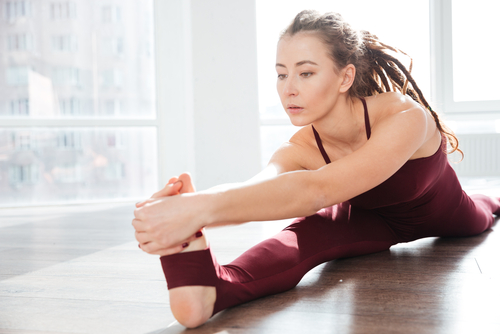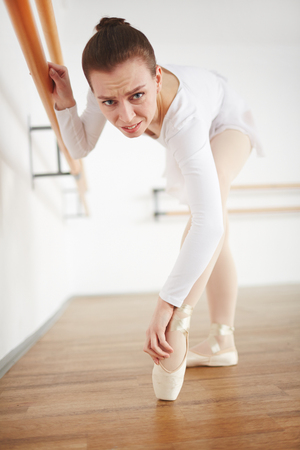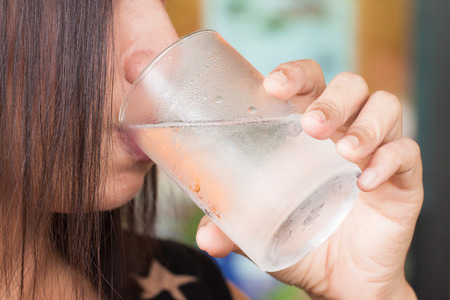Dance Talk
Our dance season never ends. Learn dance tips from the best.
How To Get Rid Of Muscle Spasms And Cramps


As an experienced dancer, it's probably happened to you a time or two before. In the middle of an intense rehearsal, you get a spasm or a muscle cramp in your foot or leg that takes your breath away and forces you to kick off those dance shoes. They're sudden and painful, seemingly coming out of nowhere. Some can throw you off track for a few seconds, a few minutes or even longer. So why do they happen and what can you do about them?
Muscle spasms are involuntary contractions of one or more muscles. They often happen without warning and can be caused by a variety of factors from dehydration to overuse. A sustained muscle spasm -- one that lasts longer than a few seconds -- is a muscle cramp. The front and back of your thighs, as well as your calves are most at risk. Just like with a muscle spasm, the cause can be from dehydration and overuse, as well as a muscle strain or holding a position for too long.
As a dancer, though, you've got to quickly push through these cramps and spasms so you can get back into your dance shoes and into the rehearsal studio. Here are some tips to help you:
Make sure you warm up.
One of the surefire ways to get a cramp or muscle spasm is to avoid a warm up before your next dance rehearsal or stage performance. Often the best way to warm up is with both dynamic stretching, such as with walking lungs, as well as static stretches. This will properly prepare all your major muscles for the intensity of your dance class by enabling more blood to flow to them and also reduce the chance of a muscle spasm or cramp. You'll be able to get more from class and rehearsals as a result.
Take things slow.
Even after you warm up, don't jump right into a super intense dance routine. Make sure you slowly ease your way into class. When you progress more slowly, your muscles will have the time they need to better cope and adjust. This, in turn, will put you at less of a risk for muscle spasms and cramps.
Stay hydrated.

When it comes to dehydration, a loss of fluids and electrolytes, such as sodium and potassium, can lead to muscle cramps. That's why it's important to drink plenty of liquids throughout the day, as well as take regular breaks to hydrate during your dance class. Keep in mind too that sometimes water is not enough. You'll need a sports drink to best replenish your body and replace lost electrolytes. The amount of fluid you consume depends on your unique body and your exertion levels.
Beyond replacing electrolytes, why are fluids so important? They are what enable your muscles to contract and relax. When you keep them well hydrated, they'll be able to function better without cramping. In addition to that, staying well hydrated can also improve your energy level, balance and performance, as a result.
Eat the right foods.
Beyond keeping yourself hydrated, it's also important to make sure you're eating the right foods. It's vital that dancers eat a balanced diet overall. But more than that, you should also be consuming foods that are rich in electrolytes. These include banana, potato, dates, raisins, spinach, beans, lentils, coconut and avocado. Eating foods that are high in electrolytes can ward off the potential for cramps and spasms. Just be sure to eat them about 30 to 45 minutes after your next class, performance or rehearsal. Shortly after a workout is when your body will be best able to absorb these nutrients and put them to use in your body.
Take those dance shoes off and walk or stretch it out.
You might not want to stop in the middle of your dance class, but if you're dealing with a serious cramp, then it's time for a break. You can take off your dance shoes and walk around the room for a few minutes until it starts to go away. Or you can stretch out the cramped muscle to release some of the pain and tightness. In addition to that, you can also massage the area where there's a cramp. Gently rubbing it can help it better relax, faster.
Relax your body.
Taking a break makes sense during a rehearsal. But when you're on the stage performing, you simply don't have that luxury. What can you do in these cases? Relax and take a few deep breaths. Think about your face, your jaw, your legs, your feet, and all the areas of your body and keeping them loose. When you're tense, it's going to lead to a spasm or a cramp; but by relaxing your mind and your body, you can get rid of cramps more quickly and also lessen the chance of them happening in the future.
Strengthen your muscles.
In the future, work to strengthen your muscles so they don't get as tired quickly, putting you at risk for spasms and cramps. When you do, don't simply work on your larger muscles, like your calves and thighs, but also smaller ones as well, like those in your feet. To do so, you can incorporate activities like picking up marbles with your toes into your regular workout routine.
As a dancer, you're going to have to deal with muscle cramps and spasms at times. Just make sure you follow the tips above to get rid of them quickly and to ensure they don't become a regular problem for you.

Follow Us
Follow Us online, join our conversations, engage with our teams around the world!